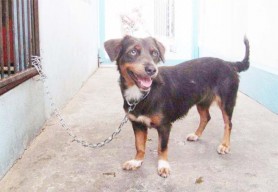Pet Corner
Continued
Stomatitis (Sore mouth)
In terms of a definition, I think the one most easily understood would reflect an inflammatory condition of the mouth which usually produces small vesicles or abscesses. These, in turn, may burst, resulting in ulcerated areas in the mouth.
Stomatitis can be the sequel to bacterial diseases, for example, the rat transmitted

leptospirosis (‘jaundice’) which abounds in Guyana, or it may result from a viral infection like canine distemper.
More often than not, oral contact with chemical irritants and corrosive poisons (acids, alkalis, Jeyes fluid, anti-tick washes, etc) are the cause of a non-specific stomatitis. Also, awns and sharp grasses sticking the inside of the mouth would be among the more common causes of ‘sore mouth.’
I should add, though, that I have seen stomatitis cases associated with other primary maladies. For example, one of the side effects of diabetes (Yes, dogs can suffer from diabetes too!) is stomatitis. If the animal has a severe kidney malfunction, then the waste matter which should be excreted through the kidneys finds its way – via the bloodstream (uraemia) – into the mouth. One can actually smell the urinous breath coming from the pet’s mouth. In such cases, reddened tissue (later even with an ulceration of the tongue and cheeks) is easily visible. The textbooks have even related vitamin deficiencies with stomatitis.
The first visible clinical sign of a stomatitis ailment is the increased discharge of a frothy saliva. Any time there is an ulceration of the tissue (with the concomitant pain), the animal will not allow you to easily investigate its oral cavity. Often, probably because of the pain, the animal stands there with its mouth open, lolling out its tongue. When eating (if it eats at all), you can actually discern that the dog is favouring, one side of its mouth (‘chewing’ with its head turned sideways).
Later, of course, if the disease is allowed to develop unchecked, the animal will stop eating altogether. The membranes of the mouth are usually reddened (inflammation), swollen and tender.

In those cases, when chemical irritants are the causative factors, the tissue on the inside of the cheek is swollen (oedematous) and may even be coated with a film of pus. In most cases, the breath of the animal has a sweetish, but obnoxious odour. The lymph nodes which drain the specific area may be enlarged and painful.
Treatment
Of course, the treatment will relate to the identification of the specific cause and correcting same, according to the severity of the lesions and the symptoms. I would firstly recommend a mild antiseptic mouthwash (eg 0.5 per cent hydrogen peroxide or a five per cent sodium bicarbonate or two per cent potassium chlorate solution). Painting the mouth (the affected spot) lightly with gentian violet may hasten recovery, but it is messy. In more severe cases, broad-spectrum antibiotics and perhaps even anti-inflammatory steroids may be brought into the therapy schedule. One may also use any of the many analgesics to deal with the pain.
There are some very specific types of stomatitis cases. We’ll deal with these next week.
Please implement disease preventative measures (vaccinations, routine dewormings, monthly anti-heartworm medication, etc) and adopt-a-pet from the GSPCA’s Animal Clinic and Shelter at Robb Street and Orange Walk, if you have the wherewithal to care well for the animals. Do not stray your unwanted pets, take them to the GSPCA’s Clinic and Shelter instead. If you do not wish your pet to have puppies or kittens, you may exploit the GSPCA’s free spay and neutering programme. If you see anyone being cruel to an animal, or if you need any technical information, please get in touch with the Clinic and Shelter by calling 226-4237 226-4237.

